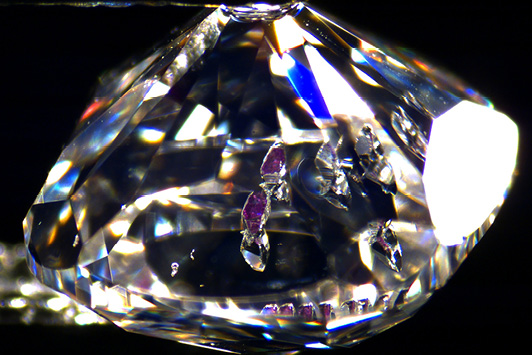
What are inclusions? In the world of gemology, inclusions are defined as
internal visible features in either a rough crystal or faceted gemstone.
Inclusions are important in gemology because they can tell trained gemologists
whether the gemstone is natural, synthetic, or treated, or even where it came
from.
Inclusions are often referred to as
“flaws” or “imperfections,” but in reality, they are part of the natural
geological process and an essential and fascinating part of gemology.
Inclusions make each diamond unique, as no two diamonds are identical, and are
even used by gemological laboratories to verify a diamond’s identity. A diamond
with natural inclusions is like a snowflake.
Inclusions can consist of other mineral
crystals that look like what they are called — for example, a break in the
crystal lattice is called a feather because it can resemble the texture of a
feather. A pinpoint inclusion is just that — it looks like a pinpoint — while
thin, elongated inclusions are called needles.
How do a diamond’s imperfections enhance it
as something unique and authentic?
Inclusions are often used to determine the relative value
of a diamond, based on their size, nature, number, position in the diamond, and
relief — or visibility — but they are also so much more. Inclusions tell us the
story of the diamond — how it formed, what it went through in the earth, and
how it got to the surface of the earth. In fact, for geologists and
researchers, the most prized diamonds are those specimens with large, visible
inclusions. Some geologists spend their entire careers studying one type of
diamond inclusion and its implications. This is because diamonds act as vessels
that can capture minerals from the mantle of the earth and can give us
information about the growth environment, and even the age of our planet. The
oldest diamonds have been dated at up to 3.5 billion years old — which is not
something you can say about a laboratory-grown diamond.
How are they formed? What conditions in the
earth need to be present?
Conditions have to be just right not only to form
diamonds, but to form the inclusions that occur within them. Diamonds are
generally theorized to have formed at depths greater than 150 kilometers, at
pressures of around
5 GPa (gigapascals) and at 1,000 degrees Celsius, and
need a specific chemistry in order to grow. This is why they are geologically
rare. Diamonds are carried to the earth’s surface by magma — molten and
semi-molten rock found beneath the earth’s surface — younger than the host
rocks in which they were formed. These two rock types in which diamonds grow in
the mantle are eclogite and peridotite, and occur at different depths in the
earth.
Diamonds are carried to the earth’s surface
in one of only three rare types of magma. The most important type of magma is
known as kimberlite, such as the Diavik mine in Canada. The Argyle mine in
Australia, famous for its pink diamonds,
is derived from a rarer type of magma, called lamproite, with an entirely
different geochemistry. Pink diamonds from Argyle often have coesite inclusions,
which are high-relief transparent crystals.
How do inclusions manifest themselves in
diamonds?
Most diamond inclusions are classified as syngenetic,
which means the inclusion forms at the same time as its host. Pyrope garnet is
an example of a syngenetic inclusion you may find in a diamond, and is usually
a dark-reddish included crystal.
Furthermore, diamonds are classified into
different types based on the amount of nitrogen that aggregates in the crystal
lattice. Some diamond types can be categorized by inclusion types, such as Ib
diamonds with clusters of dark “Ib needles.” Large cape diamonds with N2 and N3
aggregates often have high-relief transparent garnet crystals and fine,
transparent linear growth, known as “transparent graining.”
While there are still many unanswered questions
about how exactly diamonds form, their inclusions are a window into the history
of the earth, and their journey to the surface. They are an opportunity to
carry a piece of that history with you, so you can admire diamonds from the
inside out.
Image: American Gem Society (AGS)Article from the Rapaport Magazine - Special Supplement Ancient Beauty, Bold Future. To subscribe click here.